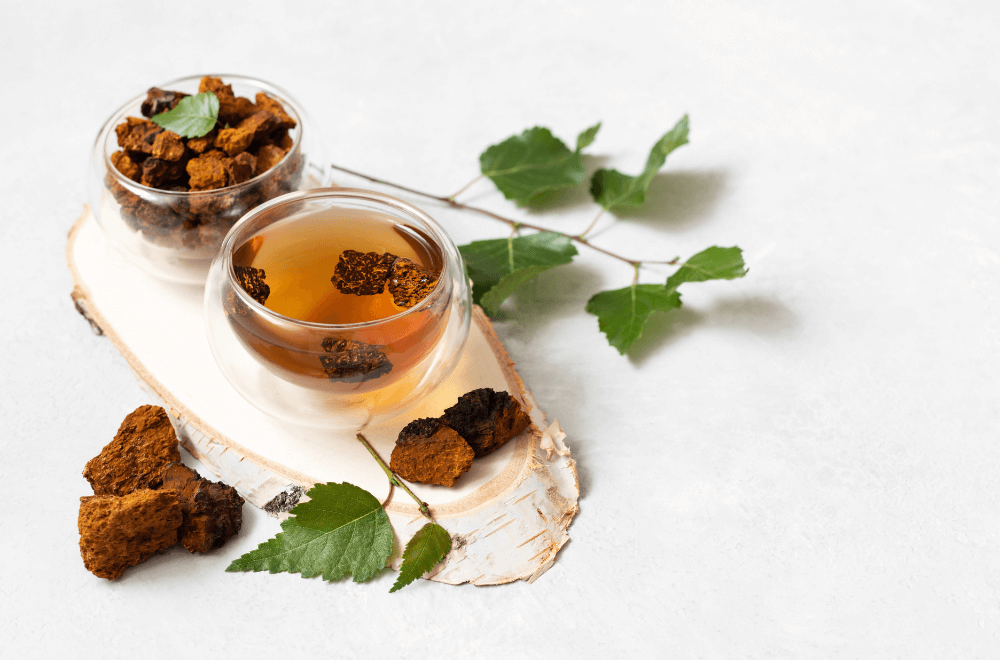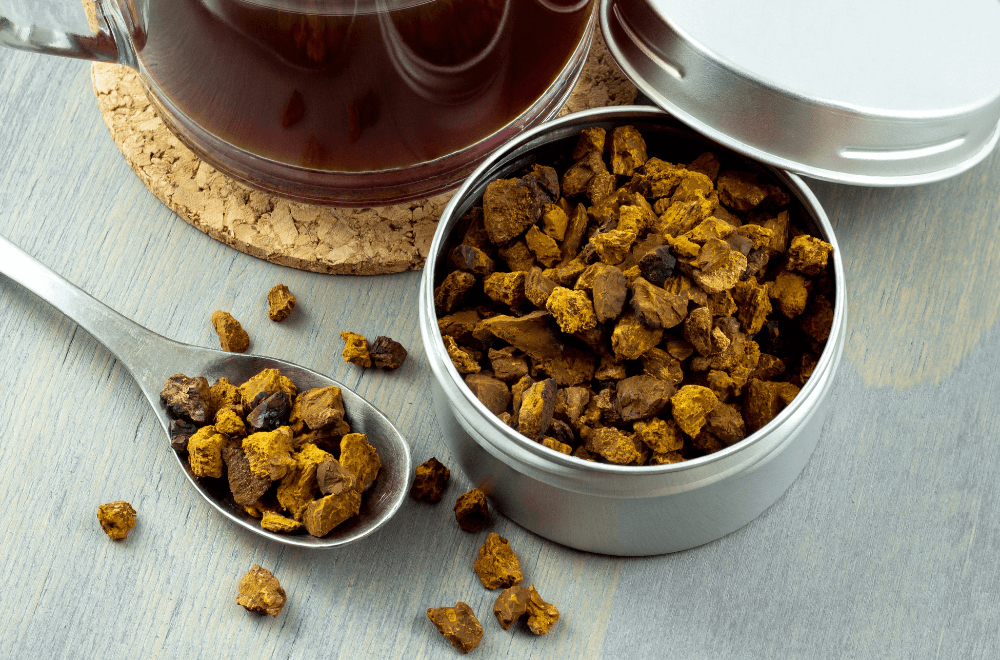You might be daunted when approaching Chaga tea, so what does Chaga tea taste like? This unique herbal tea is smoother than you think with a touch of vanilla.

The act of coming together to drink tea is found in many cultures across the globe. From the British insistence on drinking tea at the slightest provocation to the delicate and respectful nature of the Japanese tea ritual, the art of making and serving tea attracts stories and myths and holds deep cultural significance for many.
With thousands of different types of tea, from black tea to chamomile, it sometimes seems a little overwhelming to choose which one to drink! Many types of teas claim to have health benefits, some of which have yet to be proven, but one which has been the focus of several studies, Chaga tea, does have some research to back up the claims.
While growing in popularity, many people are still skeptical of any mushroom tea. So, what does Chaga tea taste like? Let’s dig in. You might be interested in our Renude Chaga Mushroom & Adaptogen Superfood Coffee Boost review.
What Does Chaga Tea Taste Like?
Chaga does not taste like mushrooms but has a mild earthy taste with a hint of vanilla (the fungus contains vanillin, also found in the vanilla bean). It’s a unique flavor with a mild bitterness. If the Chaga tastes extraordinarily bitter or very strongly of dirt, it may be contaminated and should not be consumed.
What Is Chaga?
Chaga tea is made from a parasitic fungus called Inonotus obliquus that grows on birch trees. You’ll find it frequently described as a mushroom, but that’s inaccurate. Instead, it comes from the Hymenochaetaceae family of fungi. It’s the hardened mass of mycelium known as sclerotia (or, in common terms, the sterile conk) that forms on the outside of the tree that is used to make tea.

It primarily grows on birch trees in cold climates, although it can also be found on ash, elm, beech, alder, and hornbeam trees. You should note, though, that Chaga grown on trees other than birch does not contain the constituents that are so beneficial for human health. Always check the source of any Chaga you purchase to ensure it is grown on birch and is from a reputable source.
The History Of Chaga
Chaga has a long history of medicinal use, with First Nations people in Canada and the Indigenous communities of Siberia using the fungus to heal various ailments. In the 16th century, the use of Chaga to treat stomach problems, cancer, tuberculosis, and ulcers were first documented. More recently, during the Second World War, a sweet drink using Chaga became popular as a coffee substitute in Finland.
Chaga’s name is derived from the Russian word for fungus. It is commonly found in the northern hemisphere, specifically Russia, Korea, Northern and Eastern Europe, the U.S., and Canada. The fungus has not only been drunk as a tea but there is evidence that it has also been used topically and inhaled.
Foraging For Chaga
Chaga is a slow-growing fungus, taking up to 20 years to develop fully on its host birch tree. However, if you’re lucky enough to be able to harvest wild-grown Chaga, there are several things to be aware of:
- Chaga produces a black tumor or canker outside the tree; look for it on mature silver or yellow birch. Winter is the best time to forage for the fungus as fewer leaves make the black fungus easier to spot.
- Use a small axe or hatchet to remove it carefully if you find one. Please don’t cut the entire fungus away; leave some behind so it continues to grow and can be re-harvested. It would help if you also left any cankers smaller than your fist, as these are not fully mature.
- Be careful harvesting any fungus, as some may not be safe to consume. If you’re unsure, it’s best to leave what you find.
For those who do not live in an area where Chaga grows or who prefer not to harvest the fungus, you can buy Chaga in several different forms, including powder, chunks, capsules, tablets, tinctures, or ready-made tea bags. Always practice extreme caution when foraging for mushrooms yourself; it’s best to seek advice from a professional before consuming anything.
The Benefits Of Chaga
Many claims about Chaga’s anti-cancer properties have been made, but research has not determined outright if that is the case. However, there is a stronger argument to support the fungus’ nutritional properties. Chaga is packed full of vitamins, minerals and antioxidants, and other beneficial constituents. These include:
- Fiber.
- Polysaccharides have strong anti-inflammatory properties and stimulate the immune response.
- Triterpenoids such as Betulinic acid, inotodial, and ergosterol peroxide inhibit the production of cytokines and reduce inflammation.
- Melanin.
- Beta-D-glucans, which help to regulate the immune system.
The Possible Side Effects Of Chaga
As with all supplements, caution should be taken, particularly if you have any underlying health issues. Chaga can affect blood sugar levels, so if you have diabetes, check with your doctor that it’s safe to take.
If you are taking blood thinners or you are about to have surgery, then you should also speak with your GP first, as Chaga contains constituents that potentially prevent blood clotting. Chaga may also cause issues if you are on blood pressure medication.
How To Brew Chaga Tea

If you’ve purchased Chaga that has already been processed, then you should follow the manufacturer’s instructions on how to prepare it. If you’ve harvested your own Chaga, you need to follow several steps to process the fungus before making tea with it.
- Wash any fungus you’ve harvested thoroughly. Make sure you remove any dirt, insects, or other plant material that may be present.
- Break the Chaga into smaller pieces.
- Allow the Chaga to air dry outside in a shaded area for two to three days. The fungus can then be brought indoors to complete the drying process. Leave the Chaga in a cool, dark location until it is completely dry. This may take up to a month.
- Break up the Chaga chunks further if needed and store them in airtight containers until you are ready to use them.
Once your Chaga chunks are ready and you want to make tea, all you need to do is simmer the dried fungus for at least 15 minutes over low heat (don’t allow it to boil). Some recommend simmering for an hour, while others may simmer for up to four hours.
The aim is to extract as many of the phytonutrients contained within as possible. How long you brew your Chaga is entirely up to you but take into account that the larger your Chaga chunks are, the longer you will have to steep to extract the maximum benefit.
Once you’ve brewed your tea, don’t throw the chunks away. They can be removed, dried, placed in a container, and stored in the freezer to be used again. If you liked this post, you might also enjoy our round-up of the best teas without caffeine.

